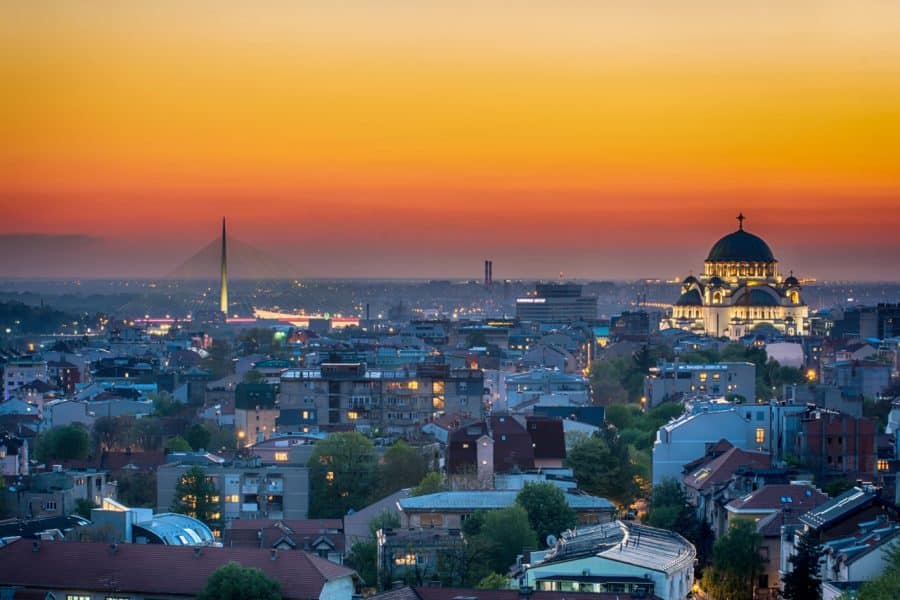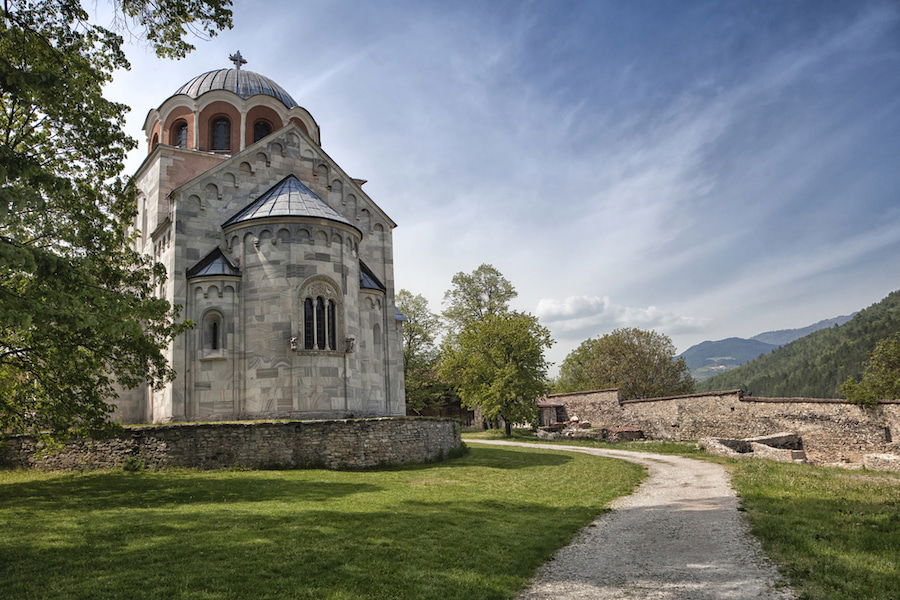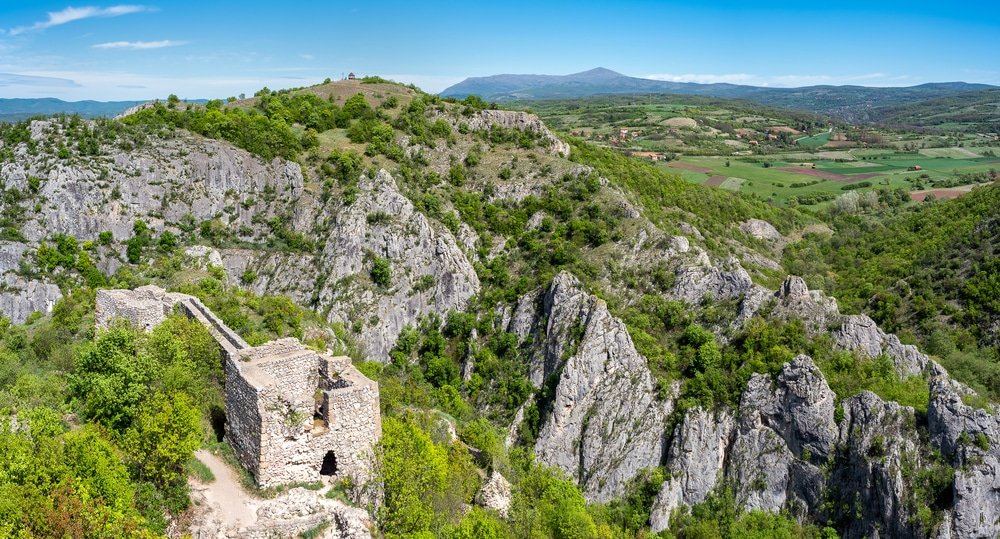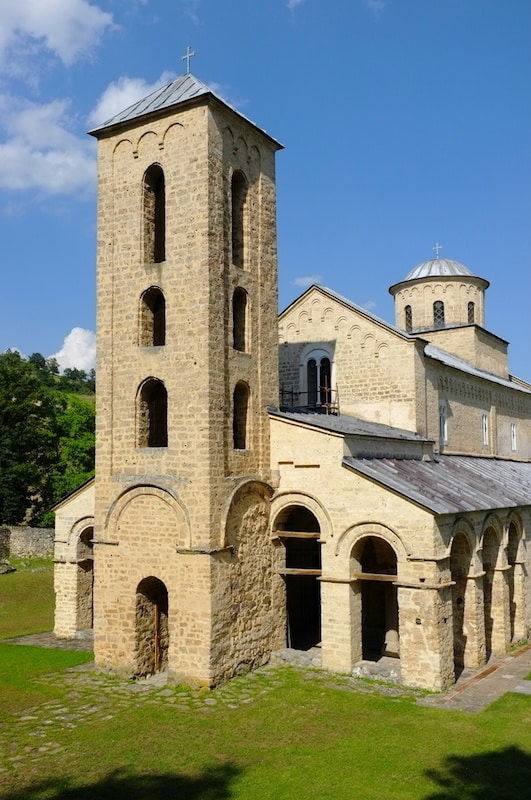Here is a list of the towns and cities in Serbia we think you will not want to miss. We’ve got Serbian cities with nature, history, art, and something for kids.
Bookmark this list of cities all worth visiting from southern Serbia to the Hungarian border covering Roman ruins, the birthplace of Constantine, nice old churches, capitals of the Roman Empire, places with the best food, fine vineyards, with so many points of interest along the way.
Join me in uncovering the best cities in Serbia.

A landlocked country in the heart of the Balkans, most people think only about a few days in Belgrade, the capital.
However, the country is home to dozens of picturesque villages and interesting towns that will get you closer to the local culture and give you a first-hand experience of the country’s Slavic traditions, fascinating legends, and rich history.
If you’re visiting the Balkan countries soon or starting to plan out your Balkan itinerary, you will be happy to learn that there is more to see and do in Serbia than you imagined.
Adding some of the settlements scattered around the country to your travel plans will bring diversity and history to your trip.
Read on to discover the best towns & cities in Serbia to explore during your next Balkan adventure.
Skip Ahead To My Advice Here!
Best Towns & A List Of Cities In Serbia To Include In Your Balkan Itinerary
The towns & cities mentioned in this article offer something for every kind of traveler: historical sites, archaeological ruins, rich museums, picturesque villages, and the possibility to explore some of the most beautiful monasteries in the Balkans.
Capital And Major Cities
1. Belgrade – Capital Of Serbia

The capital of Serbia will be your starting point to explore the rest of the country, offering plenty of lovely little places to visit and things to do. Devote a few days to Serbia’s capital before moving to the next destination.
When in Belgrade, do not miss some landmarks that have made the amazing city center so famous and shaped its gorgeous skyline. Among the places to check out, do not miss the heart of town, marked by the imposing fortress of Belgrade with its ancient citadel – the Kalemegdan Fortress.
The monumental building is surrounded by Kalemegdan Park and lying on the banks of the Danube and Sava rivers. Built in 279 BC, the fortress is free to access and is one of the most noteworthy national monuments.
Also in Belgrade, the impressive Temple of Saint Sava is a unique Serbian Orthodox church dedicated to Saint Sava, the founder of the Serbian Orthodox Church and an important figure in medieval times.
Whether you are interested in history and Serbia’s past or want to have some information about the country, try to fit in visits to the Museum of Yugoslavia. Walking around Republic Square or visiting the National Museum for an exciting insight into Serbia’s arts is also a good idea.
For kids, instead, two places will capture their attention: Belgrade Zoo and the Nikola Tesla Museum. This science museum offers the possibility to learn about the life and work of Nikola Tesla, and, among other objects, it features more than a thousand technical exhibits.
2. Novi Sad – The Serbian Athens

Among the most visited places in the country, Novi Sad is an interesting city and Serbia’s second largest. Set on the banks of the Danube River, with clear Habsburg influences visible in the local architecture. The most remarkable example is the impressive Petrovaradin Fortress on the Danube, which overlooks the well-known European river.
The Danube Park is perfect for kids visiting the area to enjoy some outdoor moments. The place was created back in 1895, and it is now a protected space, a natural monument, as well as one of the most meaningful symbols of the city.
Hidden gems in town include Novi Sad’s Old Synagogue, Novi Sad’s Art and Natural History Museum of Vojvodina, and the City Museum of Novi Sad. All of these will make your day in Novia Sad, one of the cities in Serbia you are sure to love.
3. Niš – The Third Largest City In Serbia

Niš is the third largest in importance and population right after Belgrade and Novi Sad; Nis (or Niš) cannot be missed from your Serbian itinerary.
Also in the south of Serbia, the city of Niš is located on the road that connects Belgrade to Bulgaria’s capital, Sofia, and it is a popular stop for road travelers covering the route.
Among the places, you should visit the Niš Baths, Niš fortress, and the remnants of a former concentration camp dating back to the Second World War.
Also, it’s a good idea in Nis to explore the Skull Tower, which is closely related to the Turkish past and town memories. Here, dozens of skulls are displayed, and they all come from the cruel battles against the Ottoman rule that the city endured for over 400 years.
Niš is a vibrant, modern town with a youthful vibe as it hosts a critical Serbian university.
4. Kragujevac – Fourth Largest City

Another great Serbian town, Kragujevac is an important center in the country with fascinating historic sites that pay tribute to the victims of the Nazi occupation, including Sumarice Memorial Park and its Memorial Museum of October 21st, 1941, a sad date that marks the collective memory of Kragujevac with the cruel Nazi massacre that cost the lives of over 7000 civilians.
On the premises, there is also a park where you can pay tribute to the victims in the several monuments scattered in the area.
In town, it is also possible to get lost along the many pedestrian alleys, visit the Orthodox Cathedral, and check out the old district with the gorgeous ancient church of Stara Crkva.
Brands We Use And Trust
Historical And Cultural Gems
5. Smederevo – One Of The Oldest Towns In Europe

Smederevo, sitting picturesquely along the banks of the Danube River, brings together historical depth and natural beauty.
The Smederevo Fortress, a mammoth structure overlooking the river, offers travelers a peek into the medieval past of Serbia and is an essential spot for any visitor. Wine lovers will find Smederevo particularly charming due to its robust local wine production.
The town is reachable via car or bus from Belgrade, with the journey typically taking around an hour. Enjoy the local delicacies, steep yourself in its history, and maybe even plan your visit during the Smederevo Autumn Festival, celebrating the region’s rich wine production.
6. Pancevo
This is another Serbian village dear to the hearts of locals as it hosts the Stratiste Memorial Complex Monument that pays tribute to the Holocaust of Pancevo Holocaust. This complex receives hundreds of visitors every year.
However, the small town also offers some other places to check out, including the charming alleys of the old city adorned with traditional homes and a unique two-domed church.
Also, in Pancevo, do not skip a visit to the National Museum and learn everything about beer tasting and production at the old and well-known Vajfert’s Brewery, one of the most influential breweries in the country.
And if you happen to visit in summer, head to the Bela Stena resort to enjoy a few drinks and some beach life by the banks of the Tamis and Danube rivers. Finally, for those who want religious tourism, the sixteenth-century Vojlovica Monastery is another interesting place to visit in Pancevo.
7. Studenica

If you loved Novi Pazar and decided to spend a few days in this Serbian city, then include Studenica in your itinerary. It is an easy day trip from Novi Pazar that is truly worth taking.
In the area, you can check out an important Serbian UNESCO World Heritage Site, the twelfth-century Serbian Orthodox Studenica Monastery, where it is even possible to stay if you want to spend the night in a completely different lodging.
You can reach the monastery in advance to coordinate a visit and a stay.
Stunning frescoes adorn the walls of this Medieval Serbian monastery that has been a reference center in the country for more than eight centuries.
Peaceful hills and pine groves surround the cloistered monastery, and forests, about 11 kilometers from the gorge of the Ibar River, a place of spectacular natural beauty, are also worth a visit during your stay in Studenica.
Studenica Monastery is an extraordinary example of a Serbian Orthodox monastery that has preserved most of its original structure.
8. Ruma
Ruma might fly under the radar for many, but this town in the Srem District of Vojvodina is a quaint place in Serbia that offers a glimpse into the peaceful, rural life of Serbia. It’s a stone’s throw away from the Fruška Gora National Park, which is dotted with monasteries and perfect for nature lovers and hikers.
Visit during the spring or autumn months to enjoy the outdoors at its best. Ruma suits travelers looking for a laid-back experience away from the hustle and bustle, with a side of local culture and history.
9. Soko Banja – Don’t Miss The Fortress

Nestled in eastern Serbia, Soko Banja is a haven for wellness seekers. This spa town is famed for its therapeutic waters and clean air, making it one of the go-to cities to visit in Serbia for anyone looking to unwind or seek relief from health issues.
There are beautiful parks, hiking trails, and the nearby Sokograd fortress ruins to explore. Soko Banja is ideal year-round, but spring and autumn offer the most pleasant temperatures for outdoor activities. It’s perfect for health-conscious travelers, families, and seniors.
10. Sremska Mitrovica
Sremska Mitrovica, one of the oldest cities in Europe, was once the capital of the Roman Empire during the Tetrarchy and today stands as a living museum of its illustrious past.
The city invites visitors to stroll through its historic core, where the remnants of the ancient city, Sirmium, are on display, offering an intriguing exploration of epochs gone by.
Sremska Mitrovica is also renowned for its lush green spaces and the welcoming ambiance of its cafes and restaurants along the Sava River. It’s easily accessible from Belgrade by bus, providing a leisurely journey into this historical gem.
11. Topola

If you’re into history and wine, Topola is one of the best cities to visit. This town is steeped in Serbian royal history, with the Oplenac complex showcasing the stunning St. George’s Church and the Mausoleum of the Serbian and Yugoslav Royal House of Karađorđević.
The surrounding area is also known for its vineyards, so wine tasting is a must. Topola is excellent for cultural travelers and wine enthusiasts. The best time to visit is during the grape harvest season in early fall, but it’s charming year-round.
12. Vrsac
Nestled at the foot of the Vršac Mountain, this is one of many cities of Serbia renowned for its wine production. Vrsac presents a delightful combination of natural beauty and cultural richness. The Vrsac Tower, perched atop a hill, provides breathtaking views of the town and the panoramic landscapes beyond. Visiting the local vineyards and sampling the exquisite local wines is a must-do activity when in Vrsac.
Easily reachable from Belgrade by bus or train, Vrsac promises a delightful escape from the hustle and bustle into the serene embrace of undulating vineyards and historical intrigue.
Natural And Recreational Spots
One of the places we already highlighted is also included in this category:
- Soko Banja
In addition, there are other excellent recreational spots in Serbia:
13. Kopaonik

Kopaonik is Serbia’s premier ski resort, boasting an impressive array of slopes for all levels, making it the perfect city to visit for winter sports enthusiasts. If you’re more of a summer person, don’t fret—Kopaonik transforms into a hiker’s paradise once the snow melts, with trails winding through lush forests and meadows.
The national park also offers mountain biking, paragliding, and scenic chairlift rides. Ideal for families, adventurers, and anyone in between, the best time to visit depends on what you’re after snow from December to March and green landscapes from June to September.
14. Mokra Gora
Mokra Gora, situated in the picturesque mountains between Serbia and Bosnia, is one of the most impressive cities in Serbia to visit for anyone looking to step back in time. The highlight here is the Šargan Eight, a narrow-gauge heritage railway that offers breathtaking views of the surrounding landscapes.
Don’t miss Drvengrad, a traditional wooden village created by film director Emir Kusturica. Mokra Gora is great for history buffs, railway enthusiasts, and anyone who appreciates natural beauty. It’s best visited from late spring to early fall when the weather is most accommodating for exploring.
15. Zlatibor

Especially popular in winter, Zlatibor is the country’s most famous winter sports destination. Located in the western portion of Serbia, this mountain settlement is also home to an old health spa and resort, established by King Aleksandar, to promote the region’s healthy environment and fresh air.
It is a great idea to visit Zlatibor if you’re into snowboarding or skiing; however, the place is also worth a visit even if you want to admire the spectacular Alpine landscape.
If romantic, old-time travel is what you’re looking for, then why not get there with the Sargan Eight Train? The convoys depart from Belgrade, and the ride is among Europe’s most scenic train routes.
Emerging And Unique Destinations
16. Subotica

If you plan to stay in Belgrade but want to discover nearby towns & cities taking short day trips from the capital, then the city of Subotica can be a perfect choice and a must-add to your itinerary. Not as big as Belgrade or other local towns such as the more famous city of Novi Sad, Subotica is a gorgeous town that can be seen in just a few hours.
It is well-known for its magnificent buildings with stunning facades, art nouveau townhouses, and spectacular churches in baroque style. Architecture lovers and photography fans will have tons of fun in this city.
People from other Balkan countries can easily visit Subotica as it is not far from Bulgaria. The neighboring country has heavily influenced the local culture, so it is unsurprising to find bilingual signage and a strong presence in Hungarian cuisine.
You can explore Subotica by joining an organized tour to avoid driving or public transport. This particular option is a full-day experience that includes stops in local landmarks, such as Subotica’s City Hall, Gradska Bibiloteka, and Republic Square.
The most convenient part of joining such a day tour is that it includes hotel pick-up and drop-off to avoid any public transport hassle.
17. Vranje
Less known and entirely off the beaten track, this small town is located in the southern southern part of Serbia. Home to an exciting history, the settlement boasts influences from Romans and Bulgarians and a unique Turkish feel.
Long ruled by the Ottoman Empire, the city features an interesting fortress dating back to the eleventh century and plenty of luxurious Turkish mansions, old temples, and a fabulous ancient Turkish bath.
18. Novi Pazar

Another unmissable gem in Serbia, Novi Pazar is among the most visited towns & cities in the country as it is located just a stone’s thrown away from one of the many remarkable monasteries in the Balkans, Sopocani Monastery, part of a religious complex that includes Stari Ras and several different churches, all of them Serbian UNESCO World Heritage Sites.
The whole religious complex makes Novi Pazar a pilgrimage and spiritual destination in the region.
Novi Pazar is also the most significant Bosniak center in the country, only a short ride from the nearby country of Kosovo.
In Novi Pazar, you can fully submerge in the local Islamic culture, visiting several religious sites, buildings, and some of the prettiest mosques in Europe.
19. Leskovac
Leskovac is renowned for its grilled meat, a culinary delight for anyone who appreciates hearty, savory dishes. Often hailed as the “Grill Capital of Serbia,” the city hosts the annual “Leskovac Grill Festival,” drawing gourmands and tourists to sample various meat specialties.
Beyond its culinary appeal, Leskovac offers vibrant green parks, historical sites, and engaging museums, such as the Leskovac National Museum, showcasing the rich tapestry of the region’s history and culture. Getting to Leskovac is convenient, as it is well connected with major Serbian cities by road and rail.
A popular choice among travelers is taking a bus or train from Belgrade or Nis, ensuring a journey that’s not only comfortable but also scenic.
20. Kraljevo

Kraljevo, situated in central Serbia, is crowned by the splendid Žiča Monastery, which has witnessed the coronation of many Serbian kings, earning the city its name, which translates to “the King’s Town.” Visitors can explore the monastery, soak in its history, and then unwind by the Ibar River, which gracefully meanders through the city.
Kraljevo also serves as a gateway to the Kopaonik National Park, making it a favorite among nature lovers and adventurers. Regular bus and train services from Belgrade and other major cities make Kraljevo easily accessible to explorers.
21. Uzice
Uzice, cocooned in the Dinaric Alps, is a spectacular rendezvous of natural wonder and Yugoslavian history. The city was notably a center of resistance during WWII and hosted the Kadinjača Memorial Complex in honor of the Partisan.
22. Pozarevac
About 70 kilometers from the capital, a visit to Pozarevac is another entertaining day trip for those spending a few days in Belgrade. The city is mainly known for its remarkable museum that displays objects related to local history.
There is also an impressive art gallery open to the public that features the works of many critical Serbian artists.
Fans of ancient history will be thrilled to know that not far from town, it is possible to visit the ruins of the ancient Roman city of Viminacium, its museums, and its archaeological site.
23. Zrenjanin

Zrenjanin, one of the largest cities in the Vojvodina province, hosts an array of architectural splendors that echo both the Austro-Hungarian Empire and ex-Yugoslavian influence. The City Hall, a marvelous example of neo-baroque architecture, and the
The Palace of Justice is also one of many sights that history and architecture enthusiasts will appreciate. Known for its multicultural atmosphere and several festivals, including the Days of Beer Festival, Zrenjanin offers visitors a wholesome blend of enjoyment and education. Zrenjanin is easily accessible by road, with regular bus services from Belgrade and Novi Sad.
24. Sombor
Sombor, located in the Vojvodina province, exudes an elegant charm characterized by its colorful baroque buildings, vibrant squares, and lush parks. Biking enthusiasts will particularly enjoy Sombor due to its flat terrain and numerous cycling paths, offering an idyllic way to explore the city and its surroundings.
The County Hall houses a splendid collection of art, and the Carmelite church are both spots not to be missed for its historic and aesthetic appeal. A bus or train journey from Belgrade or Novi Sad will conveniently get you to Sombor, immersing you in a world where the charm of yesteryear seamlessly melds with the pulse of modern life.
25. Pirot
Known for its traditional carpets, Pirot is a small town with a rich cultural heritage. The Pirot Fortress and Ponisavlje Museum offer insights into the local history, while the nearby Stara Planina mountain is a magnet for nature lovers, offering hiking, skiing, and rare flora and fauna.
Pirot’s cheese, meat, and other local products are a foodie’s delight. Ideal for travelers interested in culture, history, and gastronomy, the best times to visit are summer for hiking and winter for skiing.
Move This Adventure To Your Inbox & Get An Instant Freebie

No spam. Unsubscribe at any time.
How To Get To Serbia

Located just 18 kilometers from the center of Belgrade, Serbia’s Nikola Tesla International Airport receives flights from several European countries. The national carrier is Air Serbia, but other European airlines also fly to Belgrade.
Although there are direct flights from the UK, France, and Italy, there are no direct flights from the US or other countries out of the European zone, so a connecting flight from another European country is a must.
Traveling to Serbia by train from several other European countries is also possible. Serbia is connected by railway to Bulgaria, Croatia, Montenegro, Romania, and Turkey, among others. Although train travel might be slow, you will kickstart your trip by enjoying some stunning panoramas along the way.
When To Visit Serbia
If you’re not a fan of cold weather, snow, and gloomy days, head to Serbia during the European hot season. Starting in early September, spring weather offers pleasant temperatures and unique green scenarios to enjoy.
From the end of October, when autumn kicks in, days become shorter, offering less daylight and lower temperatures.
Instead, suppose you’re more of a cold-weather traveler. In that case, heading to Serbia in winter can be perfect for enjoying snow, cozy moments by the fireplace, and a few winter activities. Besides, accommodation and prices generally tend to be more convenient.
As you can see, there is much more to Serbia than just a visit to Belgrade or a quick stop in Novi Sad!


My grandfather was born there
Just found your site, its amazing. We are just planning a trip to the Balkans by motorhome, thanks for all this information.
So many new places to explore.